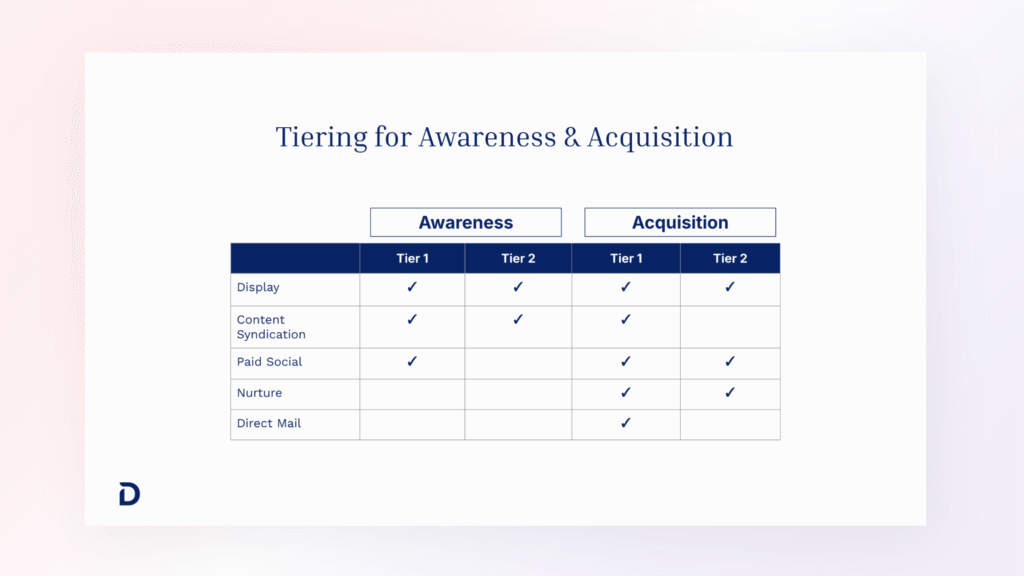How to Get Started with Account Tiering Across Digital Channels

Principle Digital Expert
-
Journey Stage
All Stages
-
Team
Marketing, Sales
-
Expertise Level
Intermediate
Contents
Partner with Demandbase Experts
Get tailored strategies and insights to optimize your approach, drive engagement, and unlock new opportunities.
What you’ll learn
This playbook provides a comprehensive, step-by-step guide to implementing account tiering into your Demandbase strategy. Tiering allows you to prioritize accounts efficiently, align with sales initiatives, and optimize your marketing spend to amplify campaign performance. By the end of this guide, you’ll know how to:
- Build an account segmentation framework using Total Available Market (TAM) and Ideal Customer Profile (ICP).
- Align tiers with buyer Journey Stages and campaign goals.
- Allocate spend per account based on prioritization and performance.
- Execute tiering across channels and campaign levels without the need for additional resources.
- Leverage insights to optimize investment and drive better results.
Why is this important?
Account tiering ensures your resources are focused where they’ll make the most impact. It strengthens communication between marketing and sales, drives measurable results, and is both scalable and low-effort to implement.
Key benefits include:
- Better sales and marketing alignment: Tiering encourages collaboration and prioritization around accounts aligned with business goals.
- Efficiency gains: Tailor spend and effort based on account tiers to maximize impact without overextending your budget.
- Scalability for growth: A low-lift process that evolves as your business needs change.
- Data-driven impact: Performance directly reflects the allocation of investment, making it easier to understand what’s working.
What you need to get started
To start implementing account tiering, ensure you have the following resources and processes in place:
- A defined TAM and ICP Framework:
- Firmographics, technographics, geographic, and industry data for accounts.
- Access to account intelligence data:
- Marketing engagement metrics (e.g., ad clicks, webpage visits).
- Sales engagement data (e.g., meetings booked, outreach activity).
- Behavioral intent signals aligned with your solutions.
- Aligned teams:
- Sales and marketing alignment on prioritization criteria and tier definitions.
- Agreement on goals for account groups.
- Target spend baselines by Tter:
- Tier 1 ($60–$75 per account)
- Tier 2 ($35–$50 per account)
- Tier 3 (Lower-tier spend per account, if applicable).
- Campaign Frameworks and Tools:
- Access to campaign management platforms equipped for dynamic segmentation, such as DemandbaseOne.
- Pre-built creative assets and messaging ready for deployment.
Step-by-step playbook
The following steps will guide you through implementing an advanced account tiering strategy. The steps are organized into parts for clarity and granularity.
Part 1. Building the tiering foundation
Step 1. Define your TAM and ICP
Start with your Total Available Market (TAM) or overall Ideal Customer Profile (ICP).

Then, break it down further into campaign- or solution-specific subsets.
- TAM for solution-specific ICPs:
- Use firmographic and industry data to categorize accounts by specific solutions they are likely to benefit from. For example, align Solution A accounts with industries showing high adoption.
- Journey stage segmentation:
- Map accounts to their buyer stage (Awareness, Acquisition, Acceleration). This is essential for tailoring messaging and content to their specific needs.
- Account tier definition:
- Define a clear tiering structure. A common three-tier model includes:
- Tier 1: High-value accounts needing personalized attention and higher spend.
- Tier 2: Secondary priority accounts with moderate spend.
- Tier 3: Broader audience groups reached with lower investment.
- Define a clear tiering structure. A common three-tier model includes:
Step 2. Align sales and marketing around a foundational set of target accounts
For account tiering to deliver maximum results, you must define priorities and align goals. Use these steps to build consensus across teams:
- Set tiering criteria:
- Collaborate with sales to identify characteristics that define Tier 1, Tier 2, and Tier 3 accounts.
- Examples of criteria may include annual revenue, employee count, tech stack, location, or open opportunities.
- Discuss how tier definitions align with existing business priorities. For instance:
- Focus Tier 1 on accounts in high-growth regions or showing the strongest intent signals.
- Collaborate with sales to identify characteristics that define Tier 1, Tier 2, and Tier 3 accounts.
- Establish shared goals and metrics:
- Create measurable KPIs for each tier, such as pipeline acceleration rate, engagement score increases, or closed-won deals.

- Ensure sales understands how marketing efforts (e.g., display ads, direct mail) will support their outreach.

- Create measurable KPIs for each tier, such as pipeline acceleration rate, engagement score increases, or closed-won deals.
- Build communication cadence:
- Schedule ongoing meetings to refine tier definitions and adjust priorities based on performance.
- Provide visibility into marketing activity for prioritized Tier 1 accounts so sales can deliver relevant follow-up.
- Agree on spend distribution:
- Get buy-in on spend differentiation between tiers. For instance, a larger display ad budget may be allocated to Tier 1 accounts, while Tier 2 accounts receive less exposure.

- Get buy-in on spend differentiation between tiers. For instance, a larger display ad budget may be allocated to Tier 1 accounts, while Tier 2 accounts receive less exposure.
Pro Tip: You don’t need perfect sales-marketing alignment or a formal tiering system to get started. One simple way to pilot a tiered approach is to work with a seller you trust. Ask them to group their accounts into three buckets: top priority, mid-tier, and lower priority. Then apply your digital marketing strategy accordingly. This kind of scrappy, collaborative test can drive impact quickly and help build the case for broader adoption.
Step 3. Tier account prioritization via data
Arming your segmentation strategy with data ensures more accurate prioritization. Leverage intent, engagement, and account characteristics for data-driven tiering.
- Use data-driven inputs to prioritize accounts:
- Account Characteristics: Incorporate data points like employee size, industry, revenue, and geography to identify high-impact accounts.
- Intent and Engagement Data: Track behaviors such as content consumption, product research, marketing/event attendance, and sales interactions.
- Open Opportunities: Elevate accounts where opportunities are currently active or in negotiation stages to Tier 1.
- Apply behavioral insights:
- Tier 1 accounts may show high-intent signals across multiple decision-makers. Example behaviors include downloading gated content or engaging in product comparisons on your website.
- Tier 2 accounts may have moderate engagement, such as lightly visiting solution pages or opening nurture emails.
- Score and segment accounts using software tools:
- Use a tiering framework within Demandbase or your CRM for dynamic segmentation. Assign tiers based on pre-defined thresholds for engagement, intent, or firmographic characteristics.
Part 2. Executing tiered campaigns
Step 1. Build tier-specific campaigns
Once accounts are tiered, create campaigns aligned with budget, audience, and outcomes for each tier.
- Create audiences for each tier:
- Tier 1 Audience:
- Handpicked accounts based on sales priorities, business initiatives, or deep engagement with your content/brand.
- Example filters include:
- Open opportunities with revenue >$500K.
- Accounts visiting high-value website pages like demos or ROI calculators.
- Tier 2 Audience:
- Broader groups of potential customers from your ICP with firmographic or behavioral alignment.
- Tier 3 Audience:
- Include all other TAM accounts with lighter personalization or volume-based outreach.
- Tier 1 Audience:
- Duplicate existing campaign frameworks:
- Use an existing campaign as the foundation for a Tier 2 campaign.
- Apply budget and targeting adjustments for Tier 1 by duplicating the Tier 2 campaign and replacing the audience list.
- Adjust spend allocation by tier:
- Allocate more budget per Tier 1 account:
- Example allocation:
- Tier 1 campaign budget = $70/account.
- Tier 2 campaign budget = $40/account.
- Monitor budgets to ensure resources are aligned with performance expectations.

- Example allocation:
- Allocate more budget per Tier 1 account:
Step 2. Deploy cross-channel strategies
Leverage a multi-channel approach to ensure you’re reaching each tier with appropriate messaging.
- Tier 1 campaign execution:
- Use high-exposure, high-touch channels:
- 1-to-1 or 1-to-few account-based display ads, email personalization, or direct mail.
- Incorporate executive outreach, such as custom landing pages and sales follow-ups.
- Use high-exposure, high-touch channels:
- Tier 2 campaign execution:
- Leverage scalable channels such as targeted paid social ads, content syndication, and email nurture.
- Ensure creative messaging still aligns with ICP pain points and goals.
- Tier 3 campaign execution:
- Broadest reach across TAM accounts using cost-effective channels:
- Standard display ads, basic email campaigns, or programmatic targeting.
- Broadest reach across TAM accounts using cost-effective channels:
- Maintain consistent messaging:
- Keep creative, landing pages, and broader ad copy consistent across tiers, adjusting tone of voice or personalization specifics as needed.
Step 3. Measure and optimize spending per tier
Track performance in real-time and optimize campaign spend to maximize impact for each tier.
- Monitor spend per account benchmarks:
- Tier 1 accounts may require higher levels of investment, as they often represent your highest potential in terms of impact on pipeline.
- Typical benchmarks include engagement metrics such as impressions (e.g., 3,000–4,000 for Tier 1)
- Redistribute budgets mid-campaign:
- Use real-time engagement insights to shift budgets to better-performing accounts within tiers.
- Drop poorly performing accounts from campaigns as warranted.
- Tie spending to velocity and results:
- Increased spend for Tier 1 accounts should directly accelerate their buyer velocity through the funnel.
Part 3. Scale campaigns and analyze performance
Continue expanding tiering efforts while refining based on what resonates most with your customers.
- Standardize tiering across use cases:
- Adopt tiering strategies across campaign types, from Awareness to Pipeline Acceleration.
- Analyze campaign performance by tier:
- Identify what efforts contributed to converting Tier 1 accounts.
- Compare account engagement across tiers to refine future content distribution.
- Implement feedback loops with sales:
- Meet with sales to evaluate the quality and timeliness of accounts passed between tiers.
- Use tiering to inform long-term strategy:
- Assess which characteristics best predicted success to improve ICP or campaign stages.
The results
Proper implementation of account tiering will drive the following measurable outcomes for your business:
- Improved efficiency and focus:
- Sales and marketing teams target the right accounts with the right level of resources.
- Reduced wasted spend on low-priority accounts.
- Better engagement with high-value accounts:
- Personalized campaigns for Tier 1 accounts deliver increased response rates, higher velocity through the funnel, and greater win rates.
- Scalable, predictable success:
- A streamlined tiering process integrates across campaigns, allowing new teams or strategies to quickly take shape.
- Data-driven decisions:
- Account intelligence ensures clear accountability for results and allows dynamic adjustments that improve results over time.
With this guide, you can implement account tiering as a repeatable framework, ensuring marketing and sales work in harmony to drive business growth and revenue impact. Use Demandbase tools to monitor, optimize, and continually refine tiering efforts as your strategy evolves.
Partner with Demandbase Experts
Get tailored strategies and insights to optimize your approach, drive engagement, and unlock new opportunities.
More Playbooks
How to Find Top Competitive Intent Keywords
Learn step-by-step how to identify top competitive intent keywords using Demandbase's tools. Gain insights to uncover competitor signals and boost your GTM strategy.
Navigating Prescriptive Sales Dashboards
Boost your sales strategies with our 'Navigating Prescriptive Sales Dashboards' playbook. Learn to prioritize accounts, track engagement trends, and tailor outreach for better results.
Transform your B2B strategy with this comprehensive playbook on implementing account-based experiences (ABX). Learn how to align teams, optimize metrics, and drive sustainable revenue growth.